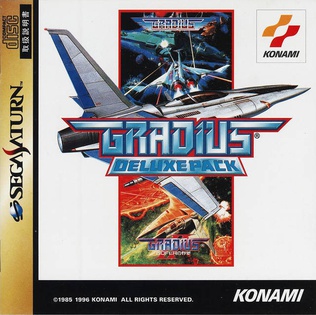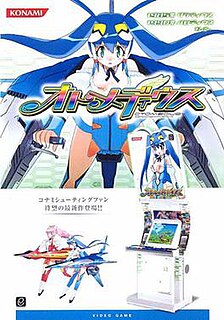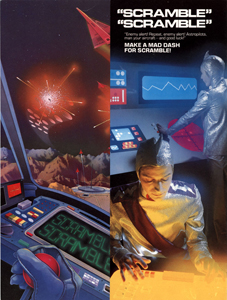 W
WCosmic Wars is a turn-based strategy video game produced by Konami in 1989 which is based upon the characters and conflicts of the popular Gradius series. It was released only in Japan. The game received a sequel in 1997, with Paro Wars, which is the Parodius equivalent of this game.
 W
WFalsion is an on-rail 3D shoot-'em-up produced by Konami that was released for the Family Computer Disk System in 1987. It is one of the few games compatible with the Famicom 3D System peripheral.
 W
WGradius is a side-scrolling shooter video game developed and published by Konami. The first game in the Gradius series, it was originally released as a coin-operated arcade game in 1985. The player maneuvers a spacecraft known as the Vic Viper that must defend itself from the various alien enemies. The game uses a power-up system called the "power meter", based upon collecting capsules to purchase additional weapons.
 W
WGradius Advance is a horizontally scrolling shooter handheld video game developed by Mobile21 and published by Konami in 2001. It was released later in the same month in the United States as Gradius Galaxies and in 2002 in Japan as Gradius Generation . It is the only Gradius title available for the Game Boy Advance. The game's plot is set between Gradius III and Gradius Gaiden. Bacterion was developing a powerful weapon to use against the planet Gradius, but it was destroyed. A few years later it crashed on a planet and the planet gradually changed into a mechanical fortress. The planet Gradius then sent the Vic Viper to stop it.
 W
WGradius Deluxe Pack is a 1996 video game compilation developed and published by Konami. It was originally released for the Sega Saturn and PlayStation, and later for Windows computers a year later. It includes the first two games in the company's Gradius series of shoot'em ups — Gradius (1985) and Gradius II (1988) — alongside extras such as CG movies and minor changes to the included titles.
 W
WGradius Gaiden is a 1997 horizontal-scrolling shooter video game developed and published for the PlayStation by Konami. Players control one of four different starships in their mission to eradicate the Bacteria army from destroying the planet Gradius. Gameplay involves shooting down enemies, avoiding their projectiles, and collecting power capsules to unlock access to new weapons. It is the fourth mainline entry in the company's Gradius franchise, and the second to be produced specifically for a home console.
 W
WGradius II is a side-scrolling shooter game. Originally released for the arcades in Japan in 1988, it is the sequel to original Gradius and was succeeded by Gradius III. Ports of Gradius II were released for the Family Computer, PC-Engine Super CD-ROM², and the X68000 in Japan. The original arcade version is also included in the Gradius Deluxe Pack compilation for the PlayStation and Sega Saturn and in Gradius Collection for the PlayStation Portable.
 W
WGradius III is a 1989 scrolling shooter video game developed and published by Konami, originally released for the arcades in Japan and other parts of Asia on December 11, 1989. It is the third game in the Gradius series. The game was ported to the Super Nintendo Entertainment System in Japan in 1990 and North America in 1991, and served as a launch title for the system in North America. The arcade version would never see the light of day in the West until it was included alongside Gradius IV in a two-in-one compilation for the PlayStation 2 and in the Gradius Collection for the PlayStation Portable.
 W
WGradius III and IV is a compilation game combining ports of the arcade versions of Gradius III and Gradius IV. It was released in Japan on April 13, 2000, and in North America and a launch title of PlayStation 2 for Europe in November 2000.
 W
WGradius IV: Fukkatsu is the fourth arcade installment in a series of scrolling shooter video games developed by Konami Computer Entertainment Tokyo. It was preceded by Gradius III, released in 1989, although spinoffs had been released prior to it such as Gradius Gaiden. This title brings a considerable graphical upgrade, particularly with the use of colored lighting. In addition, there have been several additions and removals to the vaulted weapons system; specifically, the edit mode has been removed and an online ranking system was added.
 W
WGradius ReBirth is a shoot 'em up video game for WiiWare developed by M2 and published by Konami. It is the latest installment in the Gradius series, and was released in Japan on September 2, 2008, and in North America on March 9, 2009, and in the PAL regions on July 3, 2009.
 W
WGradius V is a Japanese-developed shoot 'em up video game published by Konami for the Sony PlayStation 2 video game console in 2004. Gradius V was largely developed under contract by Treasure, who had previously worked on Radiant Silvergun and Ikaruga. The game is set predominantly in outer space where players control a fictional spacecraft called Vic Viper through a continuously scrolling background depicting the territories of Bacterian—an evil empire which serves as the player's enemy. Gradius V received overall positive reviews. Critics praised the level design, graphical design and "classic" revival, but criticized the game's difficulty.
 W
WGradius: The Interstellar Assault, released as Nemesis II: The Return of the Hero in Europe, and Nemesis II in Japan, is the second Game Boy game in the Gradius series. The game was later ported to the Konami GB Collection series of Super Game Boy and Game Boy Color compilations; it can be found in the Japanese Vol. 3 and the European Vol. 4. Like Gradius before it, these versions were renamed Gradius II for the Japanese Vol. 3 and Gradius II: The Return of the Hero for the European Vol. 4.
 W
WNemesis is a 1990 shoot 'em up video game developed and published by Konami for the Game Boy. It is part of the Gradius series. Similar to Taito's Sagaia, this game uses a once-international title for an earlier game in the series to represent a mostly original project.
 W
WNemesis 2 is a side-scrolling shoot 'em up video game released for the MSX computer in 1987 by Konami. The game is a sequel to Nemesis, the MSX version of Gradius, but is unrelated to the arcade game Gradius II. This version was ported to the X68000 computer under the name Nemesis '90 Kai , with some graphical and aural enhancements.
 W
WNemesis 3: The Eve of Destruction is a 1988 computer game, developed and published by Konami exclusively for the MSX platform in 1988. It was only released in Japan and Europe. The game is part of the long running Gradius series of side-scrolling shooters and is a spin-off of Gradius II: Gofer no Yabou. It is the second game of the series to be released exclusively for the MSX after Nemesis 2. In terms of the story; the game is a sequel to Gradius II, Nemesis 2, and the MSX conversion of Salamander. The game takes place almost 200 years after the crisis with Dr. Venom and James Burton has died in the year 6718. The Vic Viper is replaced by a new ship called the Vixen ; piloted by David Burton, a direct descendant of James who is assisted by his AI Gaudie.
 W
WOtomedius is a side scrolling shooter by Konami which featured personification of space fighters from various Konami games. The name is a pun, being a portmanteau of the terms "Otome" and "Gradius", with a set of equipment resembling space fighters from Gradius.
 W
WOtomedius Excellent (オトメディウスX is a scrolling shooter video game, developed and published by Konami for the Xbox 360 video game console. It is the sequel to the 2008 game Otomedius G , a spin-off of the Gradius series. It was released in 2011 on April 21 in Japan and in North America on November 1.
 W
WSalamander , retitled Life Force in North America and in the Japanese arcade re-release, is a scrolling shooter arcade game by Konami. Released in 1986 as a spin-off of Gradius, Salamander introduced a simplified power-up system, two-player cooperative gameplay and both horizontally and vertically scrolling stages. Some of these later became normal for future Gradius games.
 W
WSalamander 2 is a 1996 horizontal-scrolling shooter arcade game developed and published in Japan by Konami. It is the direct sequel to Salamander (1986) and the third game in the Salamander series, which itself is a spin-off of the Gradius franchise. Up to two players control two starships — the Vic Viper and the Super Cobra — as they must destroy the alien race Doom before they wipe out all of the planet Gradius. Gameplay involves shooting down enemies, collecting power-up items, and avoiding collision with projectiles or obstacles.
 W
WScramble is a side-scrolling shooter game released for arcades in 1981. It was developed by Konami, and manufactured and distributed by Leijac in Japan and Stern in North America. It was the first side-scrolling shooter with forced scrolling and multiple distinct levels, serving as a foundation for later side-scrolling shooters.
 W
WSolar Assault is a three-dimensional shoot 'em up released by Konami in 1997. A spin-off of the long running Gradius series, the title retains most of the gameplay characteristics of its 2D counterparts including the same powerups and display system. The player takes control of one of three spaceships, battling enemies and bosses in settings like tunnels, planet surfaces, and space fields.
 W
WVic Viper is an unreleased coin-op racing video game from Konami. It was to star Gradius's own signature ship, the Vic Viper, in a game resembling the F-Zero or Wipeout series. It was first shown at the 1995 JAMMA show.